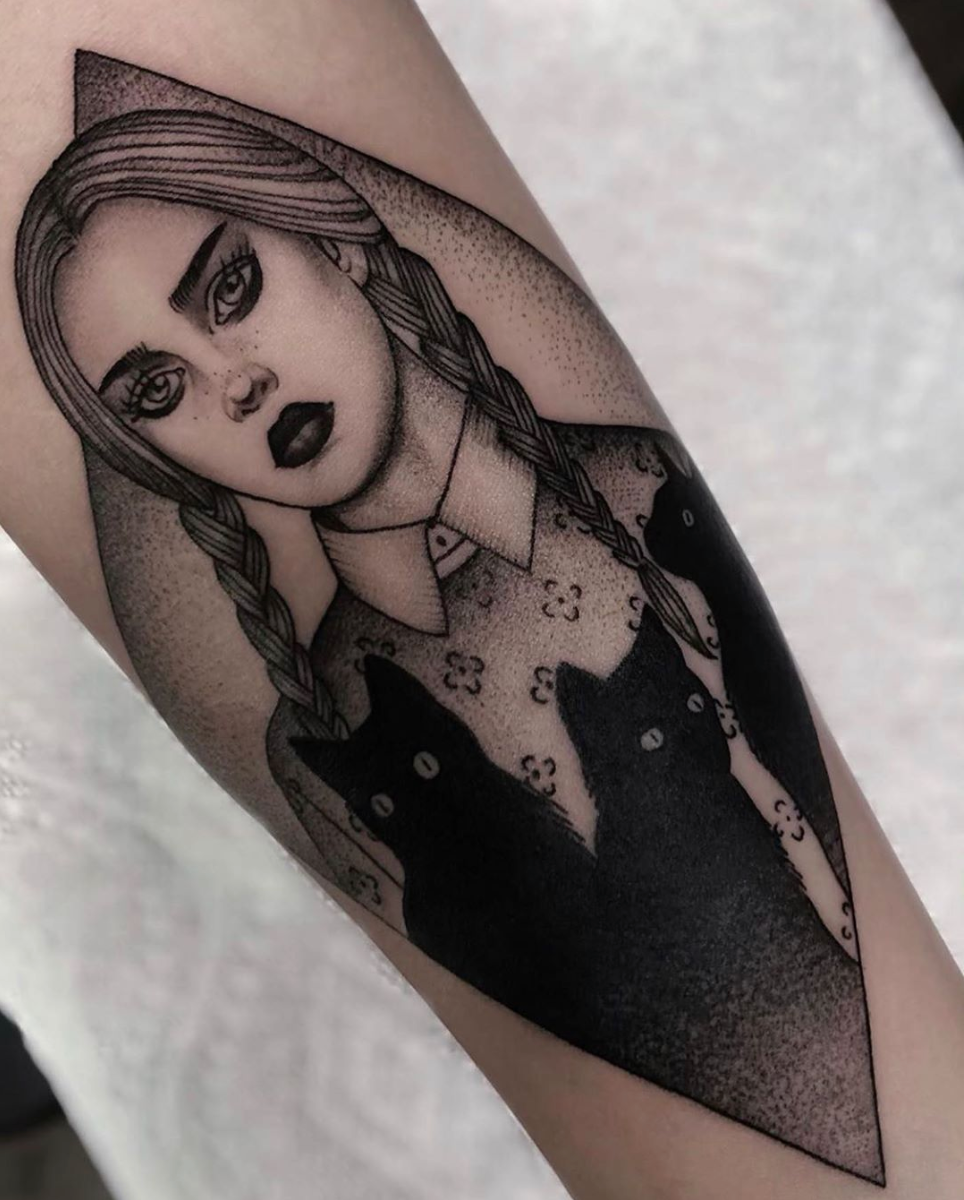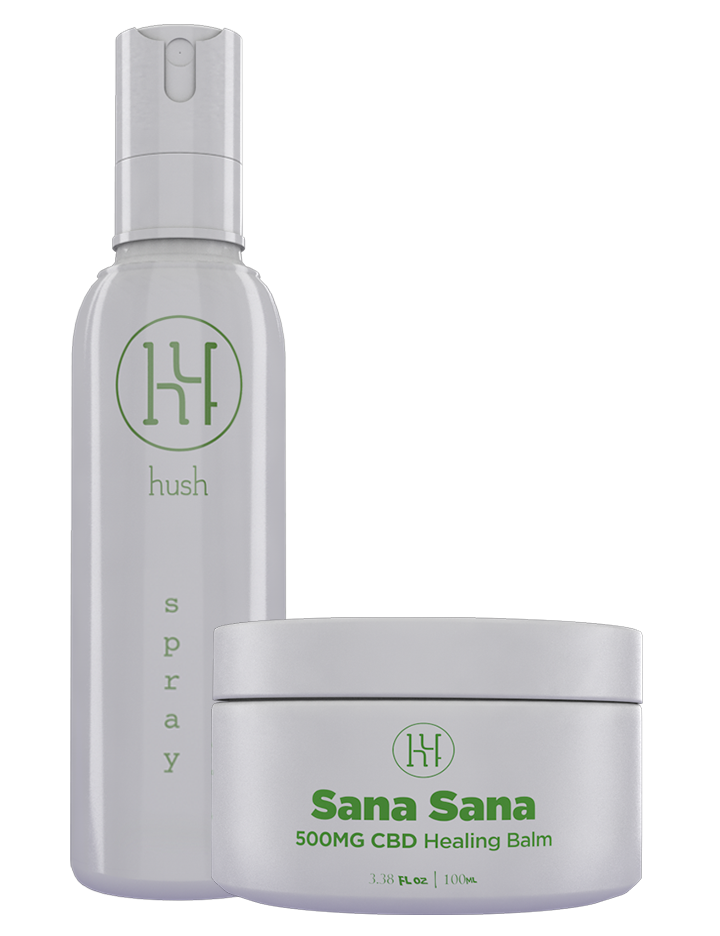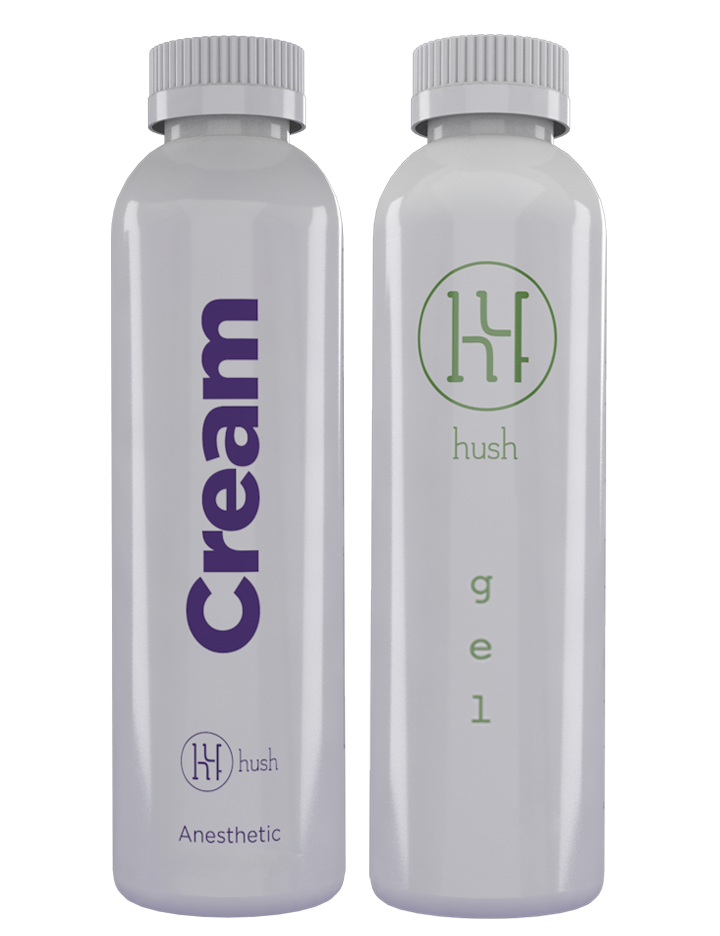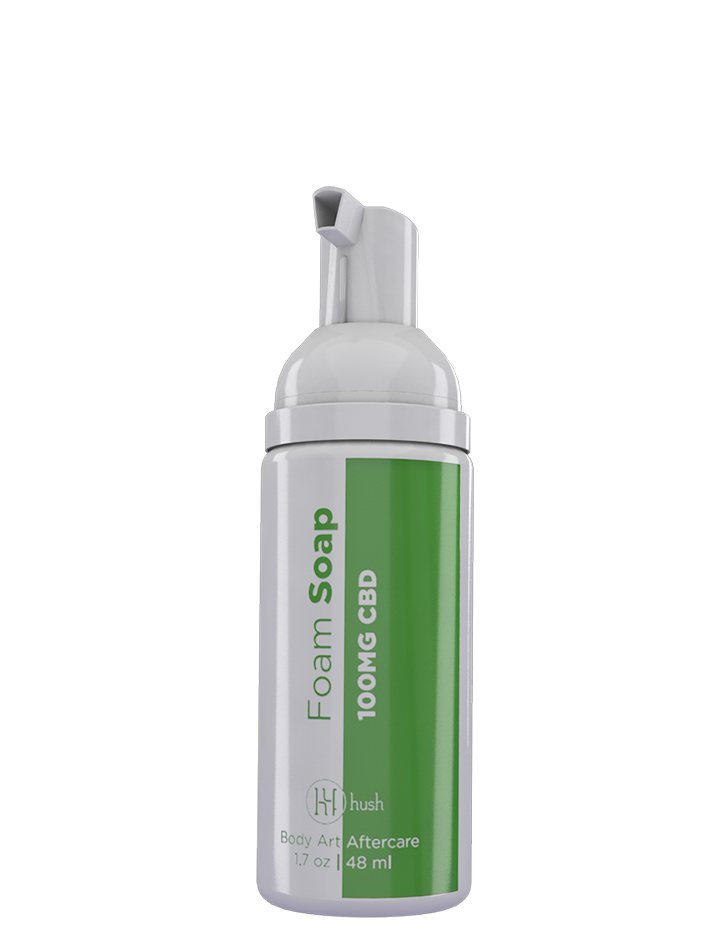
$14.99

Tattoo by Alisha Gory
Tattoos may have had a social stigma in the past, but this mindset is slowly fading away in recent years. You may be one of those who are already warming up to the idea of putting permanent art on your skin. Here at HUSH, we believe that body art is an amazing way to express yourself and show the world who you are at first glance.
However, that doesn’t mean you won’t be nervous about getting your first tattoo! Tattoos are notoriously painful, but they don’t have to be using the HUSH line of topical anesthetics.
In this article, we’ll cover how you can prepare for your tattoo, tips for your session, and how to handle aftercare so it can look as good as possible for years to come.
People say tattoos are not just about art but also the pleasure of pain. Many people marvel at the finished work and the hours of pain tolerance it took to get there.
But don’t worry, applying a pain-relieving cream or topical spray anesthesia and following our tips means bye-bye pain and hello sick body art. These seven steps should give you the most memorable tattoo experience and leave you wanting even more!
Step 1: Choosing Your Tattoo Location

Location is everything when it comes to tattoos. The location you choose for your tattoo affects the artwork and the pain level. If you’re getting tattooed for the first time, avoiding a part of your body with bony structures or tons of nerve endings is a good idea.
If you would like to skip the topical spray anesthesia, you can opt to have your tattoos placed in the following areas: the finger, outer shoulder, thigh, back of the ear, inner wrist, upper back, shin, nape, ribs, hips, stomach, and chest. But we say: don’t be a hero.
You can use topical anesthesia on even the least painful areas of the body to get tattooed, so your first session is smooth sailing. Then, you can move toward getting inked on more tender areas of the body.
You’ll also want to make sure that the location you choose for your tattoo is right for your lifestyle and a good tester location to see how you like being inked. You can always pick a body location you can cover if you want versatility.
We would steer clear of prominent areas for your first tattoo, like the hands, face, and neck. If you decide tats aren’t for you, it’s way harder to cover a large, prominent design than a tiny tattoo in a covert area.
Less Painful Tattoo Areas
For your first session, we advise picking a tattoo location that’s less painful than others. The least painful areas of the body to get tattooed will have more muscle and less bone and nerve endings. Think places like your thigh, calf, bicep, or shoulder. These spots have thicker skin and more muscle to help protect sensitive nerve endings.
You can also use our numbing cream or gel to make these tougher areas feel even less pain. If you have an enjoyable first tattoo experience, you’re more likely to want to get inked on other areas of the body. Over time, you can level up to more painful areas — but never try to get inked on one of these sensitive spots without HUSH!
More Painful Tattoo Areas
For your first tattoo, we suggest avoiding areas of the body that are bony or have more nerve endings, like the neck, elbows, ankles, hands, and feet. These areas have thin skin and a lot of nerve endings, making them a particularly ouchy spot to get inked.
Of course, with our numbing gel and numbing cream for tattoos, you can significantly lessen this pain. However, if you’ve never experienced tattoo pain before, maybe save your design idea for your second session.
If you’re determined to get a tattoo in a more sensitive area, make sure you dab on a healthy layer of topical anesthetic before heading to the tattoo studio.
Step 2: Choosing Your Tattoo Design

Choosing the style, level of detail, and design size are important when getting your first tattoo. You don’t just want to slap on a design that you’ll regret, so take the time to think about exactly what your tattoo will feel like.
If you simply want to get a taste of how getting a tattoo really feels, then you might want to opt for simpler designs that only require an outline. Designs that require shading are often the most painful, so you might want to use a topical anesthetic spray.
Don’t let potential pain steer you away from your ideal design. HUSH anesthetics can make any tattoo design pain-free. Below, we’ll explore some popular tattoo design ideas and tips for choosing your first design.
Popular Design Choices
Several design choices have become popular over time. Many people like graphic linework tattoos if they’re going for an edgy look, like an arm band or leg band. If you’re looking for a delicate design, try a tattoo of your favorite flower or several flowers that can pop in a beautiful, colorful piece.
Word and lettering tattoos are also super popular — but make sure you pick a word or phrase you won’t regret. We advise steering clear of tattooing a new partner’s name or anything you might not be in love with forever. You should also think carefully about your tattoo size and font to ensure it matches your vibe.
Doodle-style tattoos have also become very popular in recent years. Some people even build whole sleeves out of tiny doodles. This is a great way to incorporate many of your interests or small tattoos that are meaningful to you.
Tips for Choosing Your First Tattoo Design
There are a ton of different tattoo styles you can go for, from traditional tattoo designs to hyperrealism to new-school or lettering tattoos. If you plan on getting several tattoos over time, or maybe even building out a sleeve, you’ll want to be super conscious of the style you pick.
While we love mixing and matching, making your body art feel cohesive may feel important. Spend the time to decide on your favorite tattoo style and start small with your tattoo ideas.
Additionally, make sure you consider the size of the tattoo you want. When you’re just dipping your toe into the world of tattooing, a huge piece that covers your whole back might not be the best place to start — for pain, or otherwise.
Try starting with a smaller design to see how you like it. Then, you can build up your body art over time, slowly making your pieces bigger and bigger.
Of course, you need to make sure that you find a design that has meaning to you. Now, “meaning” doesn’t have to imply a deep connection to every piece on your body, but you should ensure that you’re 100% happy with your design before proceeding.
Although a tattoo removal cream is said to be in the works, other tattoo removal methods like laser tattoo removal and surgical excision are expensive and painful. You would not want to be living a life of regrets knowing that you have a permanent art on your body.
Step 3: Things To Avoid Before Getting a Tattoo
There are a few things that you should avoid right before your session, like drinking alcohol and taking painkillers like ibuprofen and aspirin. Before your session, you should steer clear of these for a day or two.
Alcohol and painkillers thin your blood, making you bleed more. The thinner your blood is, the harder it is for your body to begin healing.
These blood thinners can also make things pretty messy during your session and affect your final product. While you might be tempted to take something to dull the pain, don’t.
Oral medications and alcohol that help numb the pain during tattoo sessions are not recommended for a reason. It may be wiser to use topical spray anesthesia.
Start by applying a thick layer of our numbing cream or gel about an hour before your session, and bring along our numbing spray for longer sessions so you can touch up your numb for even the longest pain-free sessions.
Step 4: Preparing Your Skin for Tattooing

Before you head to the shop, you should take a few steps to prepare your skin and yourself for tattooing. Applying any type of topical anesthetic on the area that will get tattooed on at least a few minutes prior is recommended.
Don’t forget to wipe the area off or wash it away with soap and water before the tattoo session starts. Below, we’ll explore a few of our favorite products for getting your skin good and ready for fresh ink.
Wash Up
First, get things squeaky clean with our CBD Foam Soap. If the area you’re tattooing has hair on it, gently shave as you would normally, being careful to avoid getting razor burn or irritating the skin. Then, use our soap full of soothing natural ingredients to clean the skin and help your tattoo heal.
CBD will help keep your skin hydrated during your session, while extracts like aloe, calendula, and chamomile will soothe the skin. This antibacterial soap is also great to use during the aftercare process to help support healing.
Peace Out, Pain

Next, numb things up with our Numbing Cream or Numbing Gel. These powerful topical anesthetics use super strong lidocaine to block your nerve endings and get you nice and numb before your session. We advise opting for the numbing cream if you have super sensitive skin. You shouldn’t experience a painful tattoo session, no matter how sensitive your skin is.
Apply a thick layer of the cream or gel to the place where you’ll be getting tattooed. It’s better to apply it to a larger area than you think your tattoo will cover rather than a smaller one.
Otherwise, the edges of your tattoo might get painful! Let the numbing agent sit for about an hour, then wipe it away to reveal numb skin ready for ink.
Physical and Mental Preparation
There are a couple of ways that you should prepare your body and mind for your new tattoo. First, make sure that you eat something before your session.
While we don’t recommend a full Thanksgiving dinner, have a balanced snack to keep your blood sugar up and prevent you from getting lightheaded. You’ll also want to drink plenty of water to keep you and your skin hydrated and ready to heal.
You should also mentally prepare yourself for your tattoo. Don’t psych yourself out with nerves, and work on breathing exercises to help keep you calm during your session. Also, prepare any questions you might have for your tattooist in advance.
Step 5: Tips for When You’re at the Tattoo Parlor
If you’ve never been to a tattoo shop before your first tattoo appointment, you’ll want to brush up on these helpful tips when you’re at the parlor.Before you arrive, you’ll want to make sure that you have chosen a reputable shop and artist that use the proper sanitation methods and have the correct licensing.
Communication Is Key
Most often, there will be some minor pain that one feels during a tattoo session that cannot be prevented by any amount of topical anesthesia, especially if you’re getting a larger tattoo or one that is very detailed and takes a lot of time.
Don’t be afraid to tell your tattoo artist if you need a break! During your break, you can get a sip of water and spray a gentle mist of our Numbing Spray for target numbing touch-ups.
Tips on Tipping
It’s standard practice to tip your tattoo artist, just like you’d tip a server. Excellent service calls for a tip. If you’re impressed with your tattoo artist’s work and attitude, a standard tip is between 15 and 20 percent of the price of your tattoo.
Every tattoo artist charges a different rate. Some charge by the hour, and others charge by the size of the tattoo. Your artist’s price will depend on their location, popularity, and experience level, so communicate about the price in advance, so you’re not hit with an unexpected charge.
Step 6: The Tattoo Process

You’ve arrived at the tattoo parlor, and you’re ready to get inked! You might be worried about the pain level you’re about to experience, even if you’ve applied your numbing agent, but they say that pain is all in the mind. You may have applied tubes of topical anesthetic gel, but if you missed a spot, you are likely to feel it. Feel the pain and embrace it.
Below, we’ll lead you through all the steps you’ll take at the tattoo parlor to prepare you for your tattoo so you know what to expect for your first session. Your artist will want you to feel comfortable and prepared, so don’t be afraid to ask any questions you might have before your start or throughout your session.
Waivers and Liability
First, your artist will probably have you sign several waivers that outline your risks when getting a tattoo. Don’t panic! This doesn’t mean that you’ve chosen a shoddy shop.
This standard tattoo practice protects the artist if a client doesn’t follow the proper aftercare instructions and their tattoo gets infected or if they end up allergic to the tattoo ink.
Stencils & Tattoo Placement
After this, your tattoo artist will put your design on a stencil. If you’ve chosen your design in advance, this will be a quick process, but if your artist is drawing your design on the spot, this can take longer.
They will apply this stencil, which looks like a temporary tattoo you might have used as a kid, on the area of your body where you will get your tattoo. Your artist will ask you if the size and placement look good. This is the point of no return!
Tell your artist now if you have any hesitation or want to change anything about your tattoo! The next step of the process is to start up the needle and get you inked, so don’t think you’re being annoying if you want to change something about your artwork. Your artist wants you to love your design.
Time To Tattoo!
After you get your stencil in exactly the right size and location, your artist will lead you to the chair. Before the session starts, put yourself in a comfortable position that will allow you to hold still but still not get cramps even after an hour.
Then, you can utilize the breathing techniques you practiced before your session to work through any pain or discomfort you might feel during the tattoo. After, your artist will wrap up your tattoo in
Step 7: Follow Tattoo Aftercare Tips from the Artist
Applying topical anesthesia is only the beginning. New tattoos require care and maintenance a few days after to ensure they heal quickly and properly. Do what the artist says and enjoy the beautiful art on your skin!
The right artist will walk you through the healing process and ensure you know the proper skincare instructions inside and out. If you take care of your tattoo and follow the aftercare instructions, you can avoid getting a touch-up soon after your new ink heals.
Clean It Up
It’s important to keep a healing tattoo clean so bacteria don’t get into your tattoo and cause an infection. While it may not seem like your tattoo is susceptible to bacteria, a new tattoo is an open wound, and you should treat it as such. For a cleanser with an added boost of tattoo healing power, check out our CBD Foam Soap.
Keep it Cool
You might experience scabbing or peeling during the healing process, which can be incredibly tempting to itch and scratch. But don’t! This can make it much harder for your tattoo to heal and can even cause infection. Instead, opt for our Healing Balm or Numbing Spray to blast away the itch and cool things down.
Moisturize, Baby!
It’s important to consistently apply a thin layer of moisturizer or lotion to keep your skin hydrated and help your tattoo heal up. Hydrated skin is much more comfortable than dry, cracked skin, and you should try to keep your new tattoo as comfortable as possible while healing.
Always Use Protection
New tattoo ink can get severe damage from direct sunlight, so make sure to either cover your fresh ink up with clothing or, if you can’t, use sunscreen with a high SPF to avoid sunburn on your tattoo.
Conclusion
A tattoo is a piece of art you’ll have for the rest of your life. For our first-timers, ensure you prepare for your tattoo thoroughly so you end up with a piece of art you’ll love forever.
Sources:
What To Expect When You Get a Tattoo | Cleveland Clinic
Tattoo Infection: Signs, Causes, Treatment & Prevention | Cleveland Clinic
How Much To Tip Tattoo Artists: Why Tipping Matters | AuthorityTattoo
Tattoo Designs | AuthorityTattoo
Tattoo Sizes: How To Choose The Right Measurements | AuthorityTattoo




